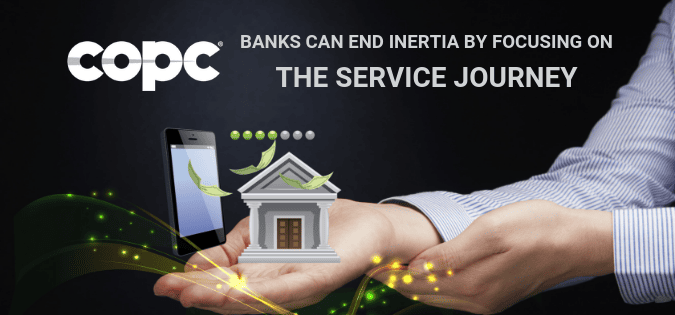
August 21, 2019
The never-ending quest for customer resolution and satisfaction is an issue that affects every industry. It is more prevalent for industries where there is a high touch-rate for customer interactions. It goes without saying that whenever a person’s finances are involved, their anxiety can raise to quite high levels if an unexpected delay or impediment puts their finances out of reach.
COPC Inc. recently completed three years of research into the experience of banking customers which revealed that the service journey customers are experiencing could be improved to achieve higher levels of customer satisfaction and loyalty.
The three, exclusive COPC Inc. Australian Banking Customer Experience Surveys, run over 2017, 2018 and 2019, reveal technology to be increasing significantly with consumer interactions, but trust remains an important issue.
Chatbots, which are still to be programmed or used to their full potential, are an area where banks would like to increase customer interaction and, ultimately, satisfaction. But the problem lies in the familiarity and comfort the average consumer has interacting with them. In our 2019 survey, only 24.50% of respondents stated that they were happy dealing with an automated banker (e.g., chatbots, mobile apps, etc.) all the time. The next 54% said only for simple transactions, while 21% said never. What those figures tell us is that humans still don’t totally trust technology simply because when things go wrong, they lose control.
A further breakdown reveals that 39% of consumers aged 45-60 have no desire ever to use an automated banker for any transactions, and that number raises to 41% for those aged 60 plus.
This follows an earlier survey question that revealed when it came to self-service banking, 84% of respondents viewed the transaction as either simple or very simple with automated banking, and they were comfortable with that. This category clearly covers paying bills, moving money from one account to another or checking an account balance.
While the age factor can be attributed to the graphs skewing higher when it comes to lack of enthusiasm to use automated banking, it is also a combination of customer interaction, trust in the system and the ability to find resolution quickly and effectively.
This goes back to the heart of the matter, which is, what is the service journey like — from the customer’s initial interaction to final transaction — on each occasion they need a service from the bank?
Do they dread interactions knowing that they are going to be drawn out and involve multiple repeat efforts to secure the answer that they want and need?
At COPC Inc., we believe getting the service journey right from the outset could go a long way to alleviating concerns with those aged 45 and above. (Interestingly, participants aged between 30 and 44 had an answer rate of 15% who said they would never use automated banking.)
What is a Service Journey?
Our definition of a service journey is the path taken by the end-user (customer) who is interacting with any combination of company support channels and resources which are required to resolve their request or need.
Service journeys are the part of the customer journey which can be controlled, managed and delivered by the operational aspects of a business, whether these are outsourced or managed internally.
Structuring a Service Journey
The reality is that simplified service journeys reduce the cost of service delivery and drive customer satisfaction and loyalty. Service journeys need to simplify communication with the customer so they achieve their end-result faster. Companies need to do the following to achieve better service journeys and, therefore, greater customer satisfaction:
- Diagnose adjacent issues.
- Anticipate future customer issues.
- Resolve unstated needs (which the customer might not know about at the time.)
- Reduce the need for the customer to call again.
Both back-end and front-end operations need to link because, if they are not in unison, a bottleneck will be created through the process, leading to a frustrated customer.
Service journeys, not individual touch points, are what you need to look at when setting priorities for your customer experience investments.
Service Journeys, we believe, are a win-win for everyone.
Another Banking Issue
The survey also revealed that one of the big issues for banks is the non-referral coming from existing customers. Although the four main Australian banks make significant profit, customer referral is the easiest and cheapest way to acquire new customers. In 2017, 57% of people surveyed had not recommended their bank to a colleague or friend in the previous 12 months; in 2018, that figure rose to 61%; and in 2019, it dropped down to 50%.
Referral marketing is the easiest and most effective way of attaining new customers, and it is an area where the banks could vastly improve.
Going Forward – Finding Resolution
In order for banks to improve their service journey output and increase customer resolutions quicker to the betterment of all, we believe that they should be focused on removing barriers and making service journeys simple.
Customers find service journeys easier as they become more familiar with the task they have at hand, so organisations need to help educate new customers about the typical service journeys they will go through. It is when a business complicates a service journey by putting barriers in front of the final transaction that customers get frustrated. The more complex a service journey becomes, the more channels a customer has to navigate. The more channels a customer has to navigate, the longer it takes to resolve their issue and the more exasperating the experience becomes.
Companies and customers are served well when service journeys are optimised within and across channels/touch points, expediting resolution, lowering cost and maximising the customer experience.
COPC Inc. can help you to increase customer loyalty and reduce operational costs through improved, decisive and conclusive Service Journey Thinking℠.